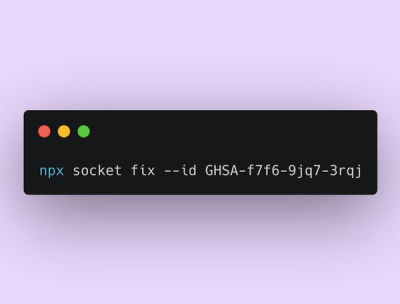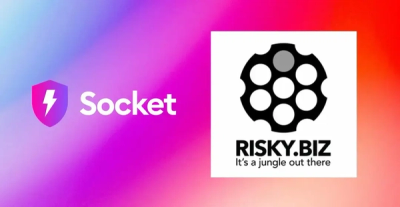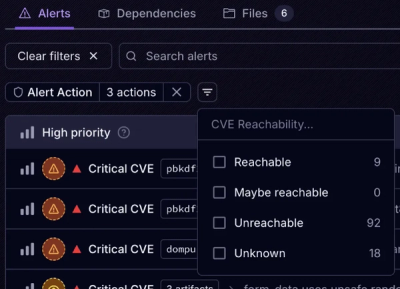
Product
Announcing Socket Fix 2.0
Socket Fix 2.0 brings targeted CVE remediation, smarter upgrade planning, and broader ecosystem support to help developers get to zero alerts.
@spectrum-web-components/underlay
Advanced tools
An `<sp-underlay>` provides a visual layer between overlay content and the rest of your application. It is commonly used with modal dialogs and other overlay elements to create a visual separation and prevent interaction with the background content while
An <sp-underlay> provides a visual layer between overlay content and the rest of your application. It is commonly used with modal dialogs and other overlay elements to create a visual separation and prevent interaction with the background content while the overlay is active.
yarn add @spectrum-web-components/underlay
Import the side effectful registration of <sp-underlay> via:
import '@spectrum-web-components/underlay/sp-underlay.js';
When looking to leverage the Underlay base class as a type and/or for extension purposes, do so via:
import { Underlay } from '@spectrum-web-components/underlay';
When using an <sp-underlay> with overlay content, place it as a sibling element before your overlay content.
<style>
sp-underlay:not([open]) + sp-dialog {
display: none;
}
sp-underlay + sp-dialog {
position: fixed;
top: 50%;
left: 50%;
transform: translate(-50%, -50%);
z-index: 1;
background: var(--spectrum-gray-100);
}
</style>
<sp-button
onclick="
console.log(this.nextElementSibling);
this.nextElementSibling.open = true;
"
>
Open dialog with underlay element
</sp-button>
<sp-underlay></sp-underlay>
<sp-dialog size="s">
<h1 slot="heading">Hello, I'm an overlay!</h1>
<p>Enjoy your day...</p>
<sp-button
slot="button"
onclick="
this.parentElement.previousElementSibling.open = false;
"
>
Close
</sp-button>
</sp-dialog>
To ensure proper layering of your overlay content with the underlay, use appropriate CSS:
<style>
/* Hide overlay content when underlay is closed */
sp-underlay:not([open]) + sp-dialog {
display: none;
}
/* Position overlay content above the underlay */
sp-underlay + sp-dialog {
position: fixed;
top: 50%;
left: 50%;
transform: translate(-50%, -50%);
z-index: 1;
}
</style>
The <sp-underlay> element helps create an accessible modal experience by:
1.7.0 (2025-06-11)
sp-overlay: Fixed : Overlays (like pickers and action menus) were incorrectly closing when scrolling occurred within components. The fix ensures the handleScroll method in OverlayStack only responds to document/body scrolling events and ignores component-level scrolling events, which was the original intention.
sp-card: Fixed: On mobile Chrome (both Android and iOS), scrolling on sp-card components would inadvertently trigger click events. This was caused by the timing-based click detection (200ms threshold) in the pointer event handling, which could misinterpret quick scrolls as clicks. This issue did not affect Safari on mobile devices.
sp-action-button: - Fixed : Action buttons with href attributes now properly detects modifier keys and skips the proxy click, allowing only native browser behavior to proceed.
sp-styles: Remove unnecessary system theme references to reduce complexity for components that don't need the additional mapping layer.
sp-card: - Fixed: sp-card component relies on sp-popover for certain toggle interactive behaviors, but this dependency was missing from its dependency tree.
sp-menu: Fixes: Icons in menu stories weren't properly responding to theme changes when used in functional story components. Switching to class-based LitElement components ensures proper component lifecycle hooks and shadow DOM context for icon initialization and theme integration.
sp-tabs: Added @spectrum-web-components/action-button as a dependency for Tabs as its used in the direction button.
sp-split-view: Added @spectrum-web-components/shared dependency in splitview since it uses ranDomId from the shared package
sp-textfield: Replace deprecated word-break: break-word with overflow-wrap: break-word to align with modern CSS standards and improve cross-browser compatibility. This property was deprecated in Chrome 44 (July 2015) in favor of the standardized overflow-wrap property.
FAQs
An `<sp-underlay>` provides a visual layer between overlay content and the rest of your application. It is commonly used with modal dialogs and other overlay elements to create a visual separation and prevent interaction with the background content while
The npm package @spectrum-web-components/underlay receives a total of 3,764 weekly downloads. As such, @spectrum-web-components/underlay popularity was classified as popular.
We found that @spectrum-web-components/underlay demonstrated a healthy version release cadence and project activity because the last version was released less than a year ago. It has 7 open source maintainers collaborating on the project.
Did you know?

Socket for GitHub automatically highlights issues in each pull request and monitors the health of all your open source dependencies. Discover the contents of your packages and block harmful activity before you install or update your dependencies.

Product
Socket Fix 2.0 brings targeted CVE remediation, smarter upgrade planning, and broader ecosystem support to help developers get to zero alerts.

Security News
Socket CEO Feross Aboukhadijeh joins Risky Business Weekly to unpack recent npm phishing attacks, their limited impact, and the risks if attackers get smarter.

Product
Socket’s new Tier 1 Reachability filters out up to 80% of irrelevant CVEs, so security teams can focus on the vulnerabilities that matter.